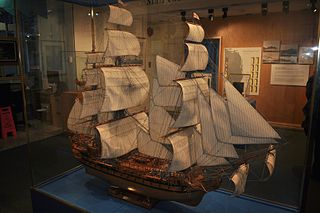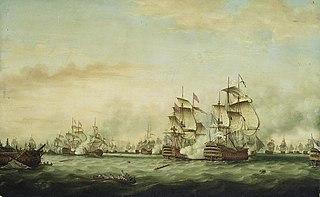
The Battle of Cape St. Vincent was one of the opening battles of the Anglo-Spanish War (1796–1808), as part of the French Revolutionary Wars, where a British fleet under Admiral Sir John Jervis defeated a greatly superior Spanish fleet under Admiral Don José de Córdoba y Ramos near Cape St. Vincent, Portugal.

HMS Bellona was a 74-gun Bellona-class third-rate ship of the line of the Royal Navy. Designed by Sir Thomas Slade, she was a prototype for the iconic 74-gun ships of the latter part of the 18th century. "The design of the Bellona class was never repeated precisely, but Slade experimented slightly with the lines, and the Arrogant, Ramillies, Egmont, and Elizabeth classes were almost identical in size, layout, and structure, and had only slight variations in the shape of the underwater hull. The Culloden-class ship of the line was also similar, but slightly larger. Thus over forty ships were near-sisters of the Bellona." Bellona was built at Chatham, starting on 10 May 1758, launched on 19 February 1760, and commissioned three days later. She was the second ship of the Royal Navy to bear the name, and saw service in the Seven Years' War, American Revolutionary War and the Napoleonic Wars.

HMS Neptune was a 98-gun second-rate ship of the line of the Royal Navy. She served on a number of stations during the French Revolutionary and Napoleonic Wars and was present at the Battle of Trafalgar in 1805.

HMS Orion was a 74-gun third rate ship of the line of the British Royal Navy, launched at Deptford on 1 June 1787 to the design of the Canada class, by William Bately. She took part in all the major actions of the French Revolutionary and Napoleonic Wars under a series of distinguished captains.

HMS Barfleur was a 90-gun second-rate ship of the line of the Royal Navy, designed by Sir Thomas Slade on the lines of the 100-gun ship Royal William, and launched at Chatham Dockyard on 30 July 1768, at a cost of £49,222. In about 1780, she had another eight guns added to her quarterdeck, making her a 98-gun ship; she possessed a crew of approximately 750. Her design class sisters were the Prince George, Princess Royal, and Formidable. She was a ship of long service and many battles.

HMS Culloden was a 74-gun third rate ship of the line of the Royal Navy, launched on 16 June 1783 at Rotherhithe. She took part in some of the most famous battles of the French Revolutionary Wars and the Napoleonic Wars before she was broken up in 1813.

The action of 15 July 1798 was a minor naval battle of the French Revolutionary Wars, fought off the Spanish Mediterranean coast by the Royal Navy ship of the line HMS Lion under Captain Manley Dixon and a squadron of four Spanish Navy frigates under Commodore Don Felix O'Neil. Lion was one of several ships sent into the Western Mediterranean by Vice-Admiral Earl St Vincent, commander of the British Mediterranean Fleet based at the Tagus in Portugal during the late spring of 1798. The Spanish squadron was a raiding force that had sailed from Cartagena in Murcia seven days earlier, and was intercepted while returning to its base after an unsuccessful cruise. Although together the Spanish vessels outweighed the British ship, individually they were weaker and Commodore O'Neil failed to ensure that his manoeuvres were co-ordinated. As a result, one of the frigates, Santa Dorotea, fell out of the line of battle and was attacked by Lion.

Neptuno was an 80-gun Neptuno-class ship of the line of the Spanish Navy. She was built in 1795 and took part in the French Revolutionary and Napoleonic Wars. She fought with the Franco-Spanish fleet in the battle of Trafalgar, and was wrecked in its aftermath.

The action of 25 January 1797 was a minor naval battle of the French Revolutionary Wars, fought in the Gulf of Cádiz. The Spanish third-rate ship of the line San Francisco de Asís was attacked and pursued for several hours by a British squadron of three fifth-rates frigates and a sixth-rate corvette under George Stewart, 8th Earl of Galloway. After an intermittent but fierce exchange of fire, the British warships, badly damaged, were eventually forced to withdraw. The San Francisco de Asís, which suffered only minor damage, was able to return to Cádiz without difficulties. The commander of the ship, Captain Alonso de Torres y Guerra, was promoted for his success.

The Príncipe de Asturias was a Spanish three-deck 112-gun ship of the line, named after Ferdinand, eldest surviving son of Charles IV of Spain and heir apparent with the title Prince of Asturias. She served during the Napoleonic wars escorting convoys, and fought at different times against both the British and French navies. Her invocation name was Los Santos Reyes.

San Francisco de Asis was a Spanish 74-gun ship of the line launched in 1767 from the royal shipyard in Guarnizo (Cantabria). She was wrecked after the Battle of Trafalgar in 1805 near Puerto de Santa Maria.

The action of 26 April 1797 was a minor naval engagement during the French Revolutionary Wars in which a Spanish convoy of two frigates was trapped and defeated off the Spanish town of Conil de la Frontera by British ships of the Cadiz blockade. The British vessels, the ship of the line HMS Irresistible and the Fifth-rate frigate HMS Emerald, were significantly more powerful than the Spanish frigates, which were on the last stage of a voyage carrying treasure from Havana, Cuba, to the Spanish fleet base of Cadiz.
The Croisière de Bruix was the principal naval campaign of the year 1799 during the French Revolutionary Wars. The expedition began in April 1799 when the bulk of the French Atlantic Fleet under Vice-Admiral Étienne Eustache Bruix departed the base at Brest, evading the British Channel Fleet which was blockading the port and tricking the commander Admiral Lord Bridport into believing their true destination was Ireland. Passing southwards, the French fleet narrowly missed joining with an allied Spanish Navy squadron at Ferrol and was prevented by an easterly gale from uniting with the main Spanish fleet at Cádiz before entering the Mediterranean Sea. The Mediterranean was under British control following the destruction of the French Mediterranean Fleet at the Battle of the Nile in August 1798, and a British fleet nominally under Admiral Earl St Vincent was stationed there. Due however to St. Vincent's ill-health, operational control rested with Vice-Admiral Lord Keith. As Keith sought to chase down the French, the Spanish fleet followed Bruix into the Mediterranean before being badly damaged in a gale and sheltering in Cartagena.
Conde de Regla was a 112-gun three-decker ship of the line built at Havanna for the Spanish Navy in 1786 to plans by Romero Landa. One of the eight very large ships of the line of the Santa Ana class, also known as los Meregildos. Conde de Regla served in the Spanish Navy for three decades throughout the French Revolutionary and Napoleonic Wars, finally being sold at Ferrol in 1815. Although she was a formidable part of the Spanish battlefleet throughout these conflicts, the only major action Conde de Regla participated in was the Battle of Cape St Vincent in 1797.

Real Carlos was a 112-gun three-decker ship of the line built at Havanna for the Spanish Navy in 1787 to plans by Romero Landa. One of the eight very large ships of the line of the Santa Ana class, also known as los Meregildos, Real Carlos served in the Spanish Navy during the French Revolutionary Wars and was destroyed with heavy loss of life during the Second Battle of Algeciras.

San Hermenegildo was a 112-gun three-decker ship of the line built at Havanna for the Spanish Navy in 1789 to plans by Romero Landa, one of the eight very large ships of the line of the Santa Ana class, also known as los Meregildos. San Hermenegildo served in the Spanish Navy during the French Revolutionary Wars and was destroyed with heavy loss of life during the Second Battle of Algeciras.

The Reina Luisa was a 112-gun three-decker ship of the line built at Ferrol for the Spanish Navy in 1791 to plans by José Joaquín Romero Fernández de Landa. One of the eight very large ships of the line of the Santa Ana class, also known as Los Meregildos. The Reina Luisa served in the Spanish Navy for three decades throughout the French Revolutionary and Napoleonic Wars, finally being wrecked off Béjaïa in 1815. Although she was a formidable part of the Spanish battlefleet throughout these conflicts, she did not participate in any major operations.

Salvador del Mundo was a 112-gun three-decker ship of the line built at Ferrol for the Spanish Navy in 1787 to plans by Romero Landa, one of the eight very large ships of the line of the Santa Ana class, also known as los Meregildos. Salvador del Mundo served during the French Revolutionary Wars until its capture at the Battle of Cape St Vincent by a Royal Navy fleet on 14 February 1797. Salvador del Mundo remained in British hands throughout the Napoleonic Wars, serving as a harbour ship, until it was sold and broken up in 1815.
Captain George Henry Towry was a Royal Navy officer of the late eighteenth and early nineteenth century who is best known for his service as commander of the frigate HMS Dido, in the action of 24 June 1795 in the Western Mediterranean Sea during the French Revolutionary Wars, when, in company with HMS Lowestoffe he successfully fought and defeated the French frigates Minerve and Artémise, capturing Minerve and driving off Artémise. He later commanded HMS Diadem at the Battle of Cape St Vincent in 1797 and served during the Napoleonic Wars on the Transportation Board.














